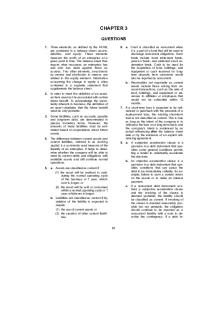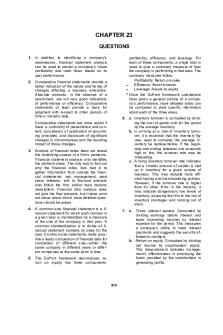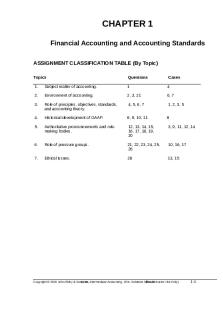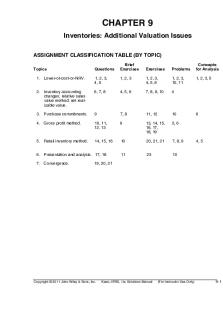Solutions Manual Intermediate Accounting 18e by Stice and Stice Ch08 PDF
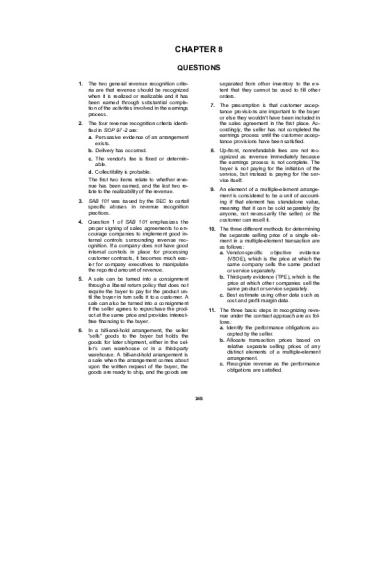
| Title | Solutions Manual Intermediate Accounting 18e by Stice and Stice Ch08 |
|---|---|
| Course | Accounting |
| Institution | Đại học Hà Nội |
| Pages | 52 |
| File Size | 809.9 KB |
| File Type | |
| Total Downloads | 58 |
| Total Views | 164 |
Summary
To download more slides, ebook, solutions and test bank, visit CHAPTER 8 QUESTIONS separated from other inventory to the extent that they cannot be used to fill other orders. 1. The two general revenue recognition criteria are that revenue should be recognized when it is realized or realizable and i...
Description
CHAPTER 8 QUESTIONS separated from other inventory to the extent that they cannot be used to fill other orders.
1. The two general revenue recognition criteria are that revenue should be recognized when it is realized or realizable and it has been earned through substantial completion of the activities involved in the earnings process.
7. The presumption is that customer acceptance provisions are important to the buyer or else they wouldn’t have been included in the sales agreement in the first place. Accordingly, the seller has not completed the earnings process until the customer acceptance provisions have been satisfied.
2. The four revenue recognition criteria identified in SOP 97 −2 are: a. Persuasive evidence of an arrangement exists. b. Delivery has occurred. c. The vendor's fee is fixed or determinable. d. Collectibility is probable. The first two items relate to whether revenue has been earned, and the last two relate to the realizability of the revenue.
8. Up-front, nonrefundable fees are not recognized as revenue immediately because the earnings process is not complete. The buyer is not paying for the initiation of the service, but instead is paying for the service itself. 9. An element of a multiple-element arrangement is considered to be a unit of accounting if that element has standalone value, meaning that it can be sold separately (by anyone, not necessarily the seller) or the customer can resell it.
3. SAB 101 was issued by the SEC to curtail specific abuses in revenue recognition practices. 4. Question 1 of SAB 101 emphasizes the proper signing of sales agreements to encourage companies to implement good internal controls surrounding revenue recognition. If a company does not have good internal controls in place for processing customer contracts, it becomes much easier for company executives to manipulate the reported amount of revenue.
10. The three different methods for determining the separate selling price of a single element in a multiple-element transaction are as follows: a. Vendor-specific objective evidence (VSOE), which is the price at which the same company sells the same product or service separately. b. Third-party evidence (TPE), which is the price at which other companies sell the same product or service separately. c. Best estimate using other data such as cost and profit margin data.
5. A sale can be turned into a consignment through a liberal return policy that does not require the buyer to pay for the product until the buyer in turn sells it to a customer. A sale can also be turned into a consignment if the seller agrees to repurchase the product at the same price and provides interestfree financing to the buyer.
11. The three basic steps in recognizing revenue under the contract approach are as follows: a. Identify the performance obligations accepted by the seller. b. Allocate transaction prices based on relative separate selling prices of any distinct elements of a multiple-element arrangement. c. Recognize revenue as the performance obligations are satisfied.
6. In a bill-and-hold arrangement, the seller “sells” goods to the buyer but holds the goods for later shipment, either in the seller’s own warehouse or in a third-party warehouse. A bill-and-hold arrangement is a sale when the arrangement comes about upon the written request of the buyer, the goods are ready to ship, and the goods are
249
250
12. A company would prefer gross revenue reporting over net revenue reporting because the larger total revenue number increases the apparent size of the company’s economic activity. If investors use a priceto-sales relationship in valuing the company, gross revenue reporting can lead to a higher stock price. 13. If percentage-of-completion accounting is to be used by construction contractors, the following elements should be present in the transaction. a. Dependable estimates can be made of the extent of progress toward completion, contract revenues, and contract costs. b. The contract should clearly specify the enforceable rights regarding goods or services to be provided and received by the parties, the consideration to be exchanged, and the manner and terms of settlement. c. The buyer can be expected to satisfy obligations under the contract. d. The contractor can be expected to perform the contractual obligation. Because most contractors with significant contract obligations have the experience to make the necessary estimates, it is recommended that they use percentage-ofcompletion accounting rather than the completed-contract method. 14. The cost-to-cost method of measuring the percentage of completion is an input method and is computed by relating the costs incurred to date to the total estimated costs. The efforts-expended methods are also input methods, but they are based on the ratio of the efforts expended by labor or machines on the contract to the total effort expected to be expended. They include labor hours, labor dollars, machine hours, or even material quantities. The percentage computed is then applied to revenue and costs to determine the amount reported for the period. 15. Output measures of percentage of completion include units produced, contract milestones reached, and values added to the contract. Particular examples of output measures include miles of roadway, cubic
Chapter 8
yards of dirt removed, or architects' and engineers' estimates of job completion. 16. The construction in progress account is used to accumulate all costs directly chargeable to a contract, including a share of indirect overhead costs and the recognized gross profit earned to date if the company is using the percentage-of-completion method. The progress billings on construction contracts account is used to accumulate the total progress billings made on a contract, including any billed retainer fees. These accounts are offset against each other on the balance sheet. If Construction in Progress is the larger of the two accounts, both are reported in the Current Asset section. If Progress Billings on Construction Contracts is larger, both are reported in the Current Liability section. 17. Some accountants feel that the costs reported under the percentage-of-completion method should always be the costs incurred to date. If the method of arriving at the percentage of completion is other than the cost-to-cost method, the only way this could occur would be to compute revenue as the sum of costs incurred and the computed gross profit rather than by applying the percentage of completion to the total contract price. 18. Under percentage-of-completion accounting, the difference between recognized revenue and recognized costs, or the recognized gross profit, is added to the costs incurred in arriving at the balance reported in the construction in progress account. 19. The major reason for a fluctuating gross profit percentage under the percentage-ofcompletion method is the revision of estimates that is inherent in this type of contract. As costs incurred differ from those anticipated, and as expectations of future costs change over the contract time period, the total gross profit to be earned on the project also changes. When some profit has already been recognized, these adjustments can create large changes in the reported gross profit percentage from year to year. These fluctuations would also increase if a measure of completion other than cost-to-cost was used and if the minority position of the AICPA Construction Contractor Guide Committee was followed.
Chapter 8
20. If a loss is anticipated on a contract, the entire loss should be recognized in the period when the loss is first anticipated. This is true under both the completed-contract and the percentage-of-completion methods. Under the completed-contract method, the amount of the expected loss is charged to a loss account and credited to Construction in Progress. Under the percentage-ofcompletion method, however, the amount of the loss plus any profit recognized in prior periods on the contract must be recognized and reported as a loss. Under either method, the balance reported in Construction in Progress will be the same. 21. The measures used to compute a percentage of performance in long-term service contracts depend on the nature of the acts of service to be performed. If the acts of service are identical or similar in nature, an output measure derived by relating the number of acts performed to the total number of acts to be performed over the contract life is recommended. If the acts are defined, but are not identical, the sales value of the acts performed to date related to the total contract sales value is used. 22. When a service company is organized and its activities grow rapidly in the early years of its life, the deferral of all revenue over the service life fails to recognize any profit on the sale of the contracts. Because the sale is the critical event in many service companies, failure to recognize profit in the early years of a company results in both direct and indirect costs being charged against very little revenue. Thus, in a newly formed company, large losses will often be shown even if the company may be profitable over time. The deferred revenue recognition method may not do an acceptable job of predicting the pattern of future cash flows. 23. The three methods of revenue recognition that await the receipt of cash are (a) installment sales, (b) cost recovery, and (c) cash. Under the installment sales method, a portion of each cash receipt is recognized
251
as income. Under the cost recovery method, no income is recognized until all costs are recovered. Under the cash method, all costs incurred are expensed immediately, and all cash receipts are recognized as revenue. Costs incurred are deferred and matched against cash received under both the installment sales and cost recovery methods. As indicated previously, under the cash method all costs are expensed immediately. 24. The installment sales method of accounting is preferred over the full accrual method if cash collection is highly uncertain and if the amount of loss due to uncollectible accounts cannot be reasonably estimated. This can occur if the sales transaction is unusual in nature and involves a customer in a way that default carries little cost or penalty. 25. Installment sales accounting requires recognition of gross profit as the cash is collected. The amount to be recognized is based on the gross profit percentage of the sales year. Because these percentages can vary from year to year, it is necessary to maintain records that identify sales and collections by year and to maintain a record of each year's gross profit percentage. 26. Interest on installment sales contracts should be recognized each period as earned. Each cash collection, therefore, should be reduced by the interest earned before the gross profit percentage is applied to the balance of the collection to determine the gross profit earned. 27. The cash method of recognizing revenue would be acceptable for reporting purposes only if the probability of recovery of product or service costs is slight. Seldom would the method be appropriate for product or real estate sales because of repossession rights held by the seller. However, in service contracts with high initial costs and great uncertainty as to collection, the cash method might be appropriate.
Chapter 8
252
PRACTICE EXERCISES PRACTICE 8–1 1. 2.
Cash.......................................................................................... Unearned Service Revenue ..............................................
1,000
Unearned Service Revenue.................................................... Service Revenue................................................................
1,000
PRACTICE 8–2 1. 2.
2.
3.
2. 3.
1,000
JOURNAL ENTRIES FOR A CONSIGNMENT 12,000
Accounts Receivable .............................................................. Sales ...................................................................................
18,000
Cost of Goods Sold................................................................. Inventory on Consignment ...............................................
12,000
12,000 18,000 12,000
JOURNAL ENTRIES FOR A LAYAWAY
Cash (2 × $50) .......................................................................... Deposits Received from Customers................................
100
Cash.......................................................................................... Deposits Received from Customers ..................................... Sales ...................................................................................
300 50
Cost of Goods Sold................................................................. Inventory ............................................................................
200
Deposits Received from Customers ..................................... Revenue from Layaway Forfeitures.................................
50
PRACTICE 8–4 1.
1,000
Inventory on Consignment..................................................... Inventory ............................................................................
PRACTICE 8–3 1.
BASIC JOURNAL ENTRIES FOR REVENUE RECOGNITION
100
350 200 50
JOURNAL ENTRIES FOR AN UP-FRONT, NONREFUNDABLE FEE
Cash (200 × $360) .................................................................... Unearned Initial Sign-up Fees ..........................................
72,000
Cash (200 × $50) ...................................................................... Monthly Service Revenue .................................................
10,000
Unearned Initial Sign-up Fees ($72,000/36 months) ............ Initial Sign-up Fee Revenue .............................................
2,000
72,000
10,000 2,000
Chapter 8
PRACTICE 8–5
253
REVENUE IN A MULTIPLE-ELEMENT ARRANGEMENT UNDER SUBTOPIC 605-25
Equipment delivery = $280,645 = $300,000 × [$290,000/($290,000 + $20,000)] Installation = $19,355 = $300,000 × [$20,000/($290,000 + $20,000)] The amount of revenue that should be recognized by Seller Company when the equipment is delivered but before it is installed is $280,645. PRACTICE 8–6 1.
2.
Accounts Receivable ($400,000 × 0.03) ................................ Commission Revenue .......................................................
12,000
Cash.......................................................................................... Accounts Receivable ........................................................
12,000
Cash.......................................................................................... Sales ...................................................................................
400,000
Cost of Goods Sold................................................................. Inventory ............................................................................
280,000
Commission Expense............................................................. Cash ....................................................................................
12,000
PRACTICE 8–7 1.
REPORTING REVENUE GROSS AND NET
400,000 280,000 12,000
Percentage of completion: [$100,000/($100,000 + $450,000)] = 18.182% $160,002 0 $160,002
Percentage of completion: [($100,000 + $150,000)/($100,000 + $150,000 + $280,000)] = 47.170% Cumulative revenue to be recognized: $880,000 × 0.47170........................................................ Revenue recognized in previous years.......................... Revenue to be recognized in Year 2...............................
3.
12,000
COST-TO-COST METHOD
Cumulative revenue to be recognized: $880,000 × 0.18182........................................................ Revenue recognized in previous years.......................... Revenue to be recognized in Year 1............................... 2.
12,000
$415,096 160,002 $255,094
Percentage of completion: 100.000% Cumulative revenue to be recognized: $880,000 × 1.00000........................................................ Revenue recognized in previous years.......................... Revenue to be recognized in Year 3...............................
$880,000 415,096 $464,904
Chapter 8
254
PRACTICE 8–8 1.
EFFORTS-EXPENDED METHOD
Percentage of completion: [150/(150 + 850)] = 15.000% Cumulative revenue to be recognized: $880,000 × 0.15000........................................................ Revenue recognized in previous years.......................... Revenue to be recognized in Year 1...............................
2.
Percentage of completion: [(150 + 300)/(150 + 300 + 520)] = 46.392% Cumulative revenue to be recognized: $880,000 × 0.46392........................................................ Revenue recognized in previous years.......................... Revenue to be recognized in Year 2...............................
3.
PRACTICE 8–9
Percentage of completion: [3,000/(3,000 + 15,200)] = 16.484% $ 145,059 0 $ 145,059
Percentage of completion: [(3,000 + 7,500)/(3,000 + 7,500 + 8,200)] = 56.150% Cumulative revenue to be recognized: $880,000 × 0.56150........................................................ Revenue recognized in previous years.......................... Revenue to be recognized in Year 2...............................
3.
$880,000 408,250 $471,750
PERCENTAGE OF COMPLETION BASED ON OUTPUT MEASURES
Cumulative revenue to be recognized: $880,000 × 0.16484........................................................ Revenue recognized in previous years.......................... Revenue to be recognized in Year 1............................... 2.
$408,250 132,000 $276,250
Percentage of completion: 100.000% Cumulative revenue to be recognized: $880,000 × 1.00000........................................................ Revenue recognized in previous years.......................... Revenue to be recognized in Year 3...............................
1.
$132,000 0 $132,000
$ 494,120 145,059 $ 349,061
Percentage of completion: 100.000% Cumulative revenue to be recognized: $880,000 × 1.00000........................................................ Revenue recognized in previous years.......................... Revenue to be recognized in Year 3...............................
$ 880,000 494,120 $ 385,880
Chapter 8
255
PRACTICE 8–10 BASIC CONSTRUCTION JOURNAL ENTRIES 1.
2.
3.
Construction in Progress ....................................................... Materials, Cash, etc. ..........................................................
100,000
Accounts Receivable .............................................................. Progress Billings ...............................................................
200,000
Cash.......................................................................................... Accounts Receivable ........................................................
180,000
Construction in Progress ..........
Similar Free PDFs

Goolsbee 2e Solutions Manual Ch08
- 14 Pages

Intermediate accounting 3 by millan
- 16 Pages
Popular Institutions
- Tinajero National High School - Annex
- Politeknik Caltex Riau
- Yokohama City University
- SGT University
- University of Al-Qadisiyah
- Divine Word College of Vigan
- Techniek College Rotterdam
- Universidade de Santiago
- Universiti Teknologi MARA Cawangan Johor Kampus Pasir Gudang
- Poltekkes Kemenkes Yogyakarta
- Baguio City National High School
- Colegio san marcos
- preparatoria uno
- Centro de Bachillerato Tecnológico Industrial y de Servicios No. 107
- Dalian Maritime University
- Quang Trung Secondary School
- Colegio Tecnológico en Informática
- Corporación Regional de Educación Superior
- Grupo CEDVA
- Dar Al Uloom University
- Centro de Estudios Preuniversitarios de la Universidad Nacional de Ingeniería
- 上智大学
- Aakash International School, Nuna Majara
- San Felipe Neri Catholic School
- Kang Chiao International School - New Taipei City
- Misamis Occidental National High School
- Institución Educativa Escuela Normal Juan Ladrilleros
- Kolehiyo ng Pantukan
- Batanes State College
- Instituto Continental
- Sekolah Menengah Kejuruan Kesehatan Kaltara (Tarakan)
- Colegio de La Inmaculada Concepcion - Cebu

